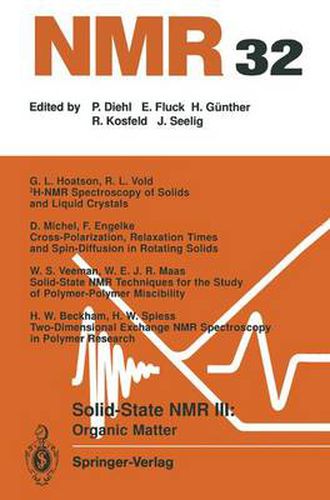Readings Newsletter
Become a Readings Member to make your shopping experience even easier.
Sign in or sign up for free!
You’re not far away from qualifying for FREE standard shipping within Australia
You’ve qualified for FREE standard shipping within Australia
The cart is loading…






This title is printed to order. This book may have been self-published. If so, we cannot guarantee the quality of the content. In the main most books will have gone through the editing process however some may not. We therefore suggest that you be aware of this before ordering this book. If in doubt check either the author or publisher’s details as we are unable to accept any returns unless they are faulty. Please contact us if you have any questions.
Solid-State NMR is a branch of Nuclear Magnetic Resonance which is presently experiencing a phase of strongly increasing popularity. The most striking evidence is the large number of contributions from Solid-State Resonance atNMR meetings, approaching that ofliquid state resonance. Important progress can be observed in three areas: Methodological developments, applications to inorganic matter, and applications to organic matter. These developments are intented to be captured in three volumes in this series, each of them being devoted to more or less one of these areas. The present volume on Solid-State NMR III is devoted mainly to organic matter. The recent developments of deuteron NMR and their applications are reviewed in the first chapter. Crosspolarization, MAS, and dynamic angle spinning are being explored for enhancement of information and sensitivity. In addition to the analysis of classical relaxation times and modern 2D spectra, detailed dynamic information becomes accessible from investigations of the relaxation time anisotropies. The second chapter examines cross-polarization in static and rotating solids under conditions of spin diffusion and thermal motion. The underlying dipole-dipole interaction is further exploited by the techniques described in the third chapter for studies of polymer-polymer miscibility. Short range techniques are discriminated from long-range techniques based on spin diffusion. The use ofthese techniques is illustrated by a case study ofPMMAJPVF blends. The last chapter addresses novel z methods and applications of two-dimensional exchange NMR for investigations of relative molecular orientations, polymer morphology, molecular dynamics, and macroscopic molecular order.
$9.00 standard shipping within Australia
FREE standard shipping within Australia for orders over $100.00
Express & International shipping calculated at checkout
This title is printed to order. This book may have been self-published. If so, we cannot guarantee the quality of the content. In the main most books will have gone through the editing process however some may not. We therefore suggest that you be aware of this before ordering this book. If in doubt check either the author or publisher’s details as we are unable to accept any returns unless they are faulty. Please contact us if you have any questions.
Solid-State NMR is a branch of Nuclear Magnetic Resonance which is presently experiencing a phase of strongly increasing popularity. The most striking evidence is the large number of contributions from Solid-State Resonance atNMR meetings, approaching that ofliquid state resonance. Important progress can be observed in three areas: Methodological developments, applications to inorganic matter, and applications to organic matter. These developments are intented to be captured in three volumes in this series, each of them being devoted to more or less one of these areas. The present volume on Solid-State NMR III is devoted mainly to organic matter. The recent developments of deuteron NMR and their applications are reviewed in the first chapter. Crosspolarization, MAS, and dynamic angle spinning are being explored for enhancement of information and sensitivity. In addition to the analysis of classical relaxation times and modern 2D spectra, detailed dynamic information becomes accessible from investigations of the relaxation time anisotropies. The second chapter examines cross-polarization in static and rotating solids under conditions of spin diffusion and thermal motion. The underlying dipole-dipole interaction is further exploited by the techniques described in the third chapter for studies of polymer-polymer miscibility. Short range techniques are discriminated from long-range techniques based on spin diffusion. The use ofthese techniques is illustrated by a case study ofPMMAJPVF blends. The last chapter addresses novel z methods and applications of two-dimensional exchange NMR for investigations of relative molecular orientations, polymer morphology, molecular dynamics, and macroscopic molecular order.